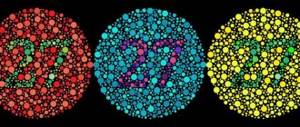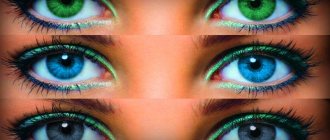Color blindness is a violation of color perception. Some of its forms may be the reason for refusal to obtain a driver's license. First, a person must undergo a special test to determine the type of pathological condition. There is a penalty for concealing the presence of a disease.
Share
Tweet
Share
Cool
Send
What is color blindness?
Color blindness is when the patient cannot distinguish one or more colors. Photoreceptors, the cones in the central part of the retina, are responsible for their perception in the eyeball. There are 3 types of cones that contain yellow, blue and red protein pigments. In the absence of one or more pigments, color perception is impaired.
According to statistics, about 8% of men and 0.5% of women suffer from color blindness.
The most severe form is lack of color vision. The patient perceives reality only in black and white. In the acquired form, only one eye may be affected. The hereditary disease affects both eyes at once.
REFERENCE. The main risk group is men. Girls quite rarely encounter this pathology.
Congenital color blindness is accompanied by low visual acuity and seeing objects colored in different shades of gray.
For a long time, color blindness can go undetected. If there is a sudden or gradual change in color perception, you should immediately consult a doctor. This may indicate a disease of the visual system or brain damage.
This pathology worsens a person’s quality of life. Such a diagnosis can become an obstacle to working as a driver, doctor or military officer.
There are no specific preventive measures. Non-specific methods include consultation with a geneticist during pregnancy planning and regular ophthalmological examinations.
What is the penalty for concealing vision pathologies?
Due to the fact that driving licenses are prohibited for patients with color anomalies in 2018, many decide to take illegal actions. Medical certificates with positive results of an ophthalmological examination are obtained through illegal methods.
Criminal liability is provided for such offenses. Illegally obtaining documents to register rights is considered fraud. For using a fake ID, a fine of up to 80 thousand rubles is imposed. If the owner of a car is diagnosed with deuteranopia and has a driver's license, a restriction of freedom of up to 24 months is possible.
Is it possible to get a license if you have color vision anomalies? This question is relevant for many future drivers. Driving vehicles is prohibited for any form of color blindness. Illegally obtaining medical certificates and certificates faces severe criminal penalties.
Causes
In most cases, color blindness is hereditary. A mother may simply be a carrier of genes, but not have the pathology itself.
Some forms of this disease may be an individual feature of the body. For example, there are patients who have difficulty distinguishing red or green colors, but at the same time they can see many more shades of khaki in comparison with a healthy person.
Other reasons:
- cataract;
- retinal injury;
- damage to the optic nerves;
- side effect from long-term use of medications;
- benign or malignant neoplasm;
- damage to the occipital lobe of the brain;
- retinal degradation;
- prolonged exposure to ultraviolet radiation on the organs of vision;
- age-related changes in the lens.
Color blindness can occur due to cataracts, diabetic retinopathy and Parkinson's disease. With cataracts, there is a decrease in visual acuity, narrowing of vision and clouding in the pupillary area. Eye injury is accompanied by deviations in color perception, pain, burning and increased lacrimation.
Temporary color blindness is caused by intoxication of the body or severe poisoning.
Clinical picture
Healthy people are called trichromats. All their cone receptors work simultaneously, providing a colorful image of surrounding objects.
Deuteranomaly, as a type of dichromasia, is a special color perception of the surrounding world. With this anomaly, only two types of cones work in the retina. Individuals suffering from deuteranomaly or deuteranopia are unable to distinguish certain shades of the spectrum, as are protanopes and tritanopes, who perceive the color spectrum somewhat differently than ordinary people.
To perceive all shades, dichromats use only two basic colors.
During the review, deuteranopes are dominated by swamp green and yellowish shades, while the red color can be partially replaced by blue, green or brown.
In other words, colorblind people perceive red, blue and green in different proportions:
- with deuteranomaly, people perceive more green color;
- with protanomaly - red. At the same time, a person may have difficulty distinguishing between black and red, comparing it with brown and gray (sometimes even with green);
- with tritanomaly, changes in blue and yellow shades are felt. People see blue and lilac tones as gray and black. This disorder is much less common than other anomalies.
Only 0.01% of the population suffers from complete color blindness. This pathology is called monochromia (achromatopsia). The only shades that monochromats can distinguish are black and white. At the same time, they see the world around them in gray tones of varying intensity.
Features of protanopia and deuteranopia
Color blindness can be divided into protanopia and deuteranopia. The first is a pathology that is characterized by the inability to distinguish between certain colors and shades of yellow, green, blue and purple. There is a lack of red pigment in the eye receptor.
The patient may perceive light green as well as orange, but he does not distinguish purple from blue. In this case, the patient can distinguish blue from green and green from dark red.
This type of color blindness is quite dangerous for the driver, since he will inadequately perceive the main traffic light signals - prohibiting and allowing.
Deuteranopia is characterized by the inability to distinguish the color green. Instead, a person sees pink and orange. As a result, the driver can easily confuse traffic lights.
Types and classifications
Color blindness can be congenital or acquired. The disease is also classified depending on the color, which a person cannot distinguish.
Congenital
In this form of the disease, as a rule, both organs of vision are affected. Such color blindness is not capable of progression, and in most cases is transmitted from mother to son.
The congenital form has the following varieties:
- Trichromasia. A type of disorder in which all three cones function, but color recognition is difficult.
- Dichromasy is the absence or cessation of function of one type of receptor.
- Achromasia. The inability of a person to distinguish between all three colors. This anomaly is detected in extremely rare cases.
In turn, dichromasia is divided into the following types:
- Protanopia is a pathology in which a person has difficulty distinguishing red shades.
- Tritanopia is the absence of perception of the color blue.
- Deuteranopia is a type of color blindness characterized by the inability to perceive green hues.
Congenital color vision impairment cannot be treated and affects the patient’s quality of life only when choosing a profession.
Acquired
There is another form of the disease - acquired. In this case, distortion of color perception can be provoked by various external factors (damage to the skull, use of medications, ultraviolet injuries to the retina, cataracts, glaucoma, etc.).
Most often, with acquired color blindness, people have difficulty distinguishing between yellow and blue shades.
Diagnostics
To confirm the diagnosis and determine the type of pathological condition, diagnostics are performed. For this purpose, special polychromatic tables are used.
How and where can I take the test?
An eye test for color blindness can be done by an ophthalmologist at the clinic at the place of medical examination. The doctor uses two types of polychromatic tables: Rabkin and Ishihara. Each of the images is a combination of numbers and figures, which consist of a large number of circles. They are different colors, but the same saturation. The check is carried out on 27 tables.
Alex Rabkin's tables are tables with numbers. The Ishihara color test takes the form of special color paintings. The drawing is done in different shades.
For the accuracy of the results obtained, certain conditions must be met:
- the patient's back to the window;
- placement of tables at eye level;
- table demonstration time is from 5 to 7 seconds;
- no high temperature;
- normal human well-being;
- good natural lighting in the room.
A person who does not see some colors will not see numbers and figures. If the test was carried out under inappropriate conditions, the patient may challenge the results.
There is also the option of instrumental examination of the retina. Anomaloscopy is performed using special color filters. This is the most accurate and progressive technique.
Symptoms
With achromatopsia, the symptoms are predominantly subjective, but there are also several objective signs of pathology. Many people are concerned about how colorblind people see colors. For example, the full form is characterized not only by black-and-white vision, but also by farsightedness with nystagmus. Vision does not always decrease, but often, this occurs due to the low sensitivity of the macula receptors to light. The development of high sensitivity to light is also possible.
Photophobia is not a mandatory but common symptom of achromatopsia.
The above symptoms may be complicated by strabismus. With an incomplete form of the disease, all of the above symptoms may appear, but they are less pronounced. This happens due to disruption of the functioning of some receptors (about one third). You can learn about friendly strabismus here.
In most cases, symptoms appear in childhood.
Farsightedness in children develops in rare cases; hemeralopia and photophobia are possible, but not common. Subjective symptoms include a violation of color perception - for example, only green and red shades cannot be distinguished.
The impact of the disease on obtaining a driver's license
According to the study, color blindness has no effect on road safety. Such a person cannot distinguish between traffic lights, but he clearly sees which of the lights is on.
The greatest danger comes from the cars driving ahead. A driver with impaired color vision will have difficulty understanding whether the brake or reverse signal is on.
Despite this, it is almost impossible for a patient with impaired color vision to obtain a driver’s license. Previously, rights were not given to people with dichromasia, that is, the loss of only one color. Nowadays, even small deviations from the correct color perception can become a problem.
If a person has a slight degree of color blindness and managed to obtain a license before 2012, then he needs to obtain a certificate for permission to drive. This is done if it is necessary to replace an old driver's license.
If you are blind to the color green, you have a chance to get a license. They can be issued only for personal use, without the right to work as a driver.
The procedure for obtaining a medical certificate for the traffic police
The first step is to collect all the necessary documents. Required:
- passport;
- military ID or registration;
- 3x4 photos.
You need to visit the fluorography office in advance. A woman needs to obtain a certificate from a gynecologist about the absence of pregnancy or a certificate about its successful course.
An examination by a psychiatrist and narcologist should be carried out in a specialized medical organization of the municipal or state health care system.
Payment must be made before the medical examination. The exact amount depends on the medical organization. On average, you will need about 2000-5000 rubles. After this, the medical worker must issue a medical card and a medical certificate form for the driver.
To obtain a driver's license, examination by the following specialists is required:
- general practitioner or family doctor;
- psychiatrist;
- psychiatrist-narcologist;
- ophthalmologist.
If necessary, the therapist can refer you to a neurologist. A narcologist can give a referral to determine the presence of psychoactive substances in the urine. A study of the vestibular apparatus is being carried out.
The following tests are also required:
- blood glucose level;
- determination of Rh factor and blood group;
- general blood and urine analysis.
If a person does not have any serious illnesses, then the medical examination will proceed quickly.
Requirements for color perception
The main color perception requirement for motorists is the ability to distinguish traffic light signals. A minor color anomaly of type A is acceptable.
Responsibility for falsifying medical examination results
Color anomaly is a reason for refusal to obtain a license. However, there will be people who want to forge a certificate. In the Criminal Code of the Russian Federation, this action is regarded as fraud.
Penalty for producing a forged document:
- imprisonment for up to 2 years;
- forced labor for up to 2 years;
- arrest - up to six months.
The person who provided the fake medical certificate is also responsible. In this case, the following punishment is provided:
- correctional labor – up to 2 years;
- arrest - up to six months;
- fine;
- compulsory work – 480 hours.
Responsibility for falsifying medical examination results
According to current legislation, color blindness in all its forms does not allow a driver to obtain a license and drive a car. Therefore, the diagnosis, which is a death sentence during a medical examination, is often attempted to be hidden through fraud. Citizens considering such a decision should understand that medical examination of vehicle drivers is a procedure protected by law.
Any fraud with a certificate of color blindness is subject to criminal prosecution under Article 327 of the Criminal Code of the Russian Federation. Not only for issuing a fake certificate, but also for purchasing it from criminals, the driver may face:
- 2 years of compulsory work;
- imprisonment lasting the same length of time;
- fine 80 thousand rubles.
Despite the fact that the legislation contains a disappointing answer to the question of whether colorblind people are given rights, it is not worth committing a crime. Forged documents are detected when checking the driver at the traffic police, so if you have vision problems, this option will still be a dead end.
To summarize, it should be stated that according to Russian laws in 2021, a colorblind person, regardless of the form of deviation, can only obtain rights if he changes them after the expiration of the statute of limitations for documents issued before 2012. For everyone else, there is only one option - passing your license in the state closest to Russia, which is a member of the Vienna Convention and does not impose medical restrictions on the driver due to color blindness. Countries that have signed the document allow foreigners to travel using their national license.
Is the pathology treatable?
There is no cure for color blindness. There are ways to correct color vision. For example, wearing special glasses or lenses is prescribed.
When choosing such optics, you need to consider some nuances:
- glasses may not fit; about 10% of patients do not see a difference;
- the addiction process can take from 30 minutes to several days;
- some types of lenses only work in natural light;
- Too “bright” actualization of color and parallel coloring of other colors may be observed.
Optics will be effective only for violations at the level of individual colors. One of the most famous manufacturers is EnChroma. Initially, they produced special visors for surgeons to better distinguish flesh from blood.
The principle of operation of lenses is based on the fact that they transmit only primary colors - red, blue and green. At the same time, they enhance their perception. The patient does not see that part of the spectrum that interferes with distinguishing primary colors.
The second option for glasses is products from Pilestone. They are cheaper and have a fairly large number of models.
There are 5 types of contact lenses for different types of color blindness. Such products have a higher level of light transmission compared to glasses. They are more convenient to use for working at a computer or in poor lighting conditions.
Corrective glasses and lenses are an individual accessory that works differently for each patient. The choice of product depends on the type of pathological condition and other recommendations of the specialist.
Expert opinion
Danilova Elena Fedorovna
Ophthalmologist of the highest qualification category, Doctor of Medical Sciences. Has extensive experience in diagnosing and treating eye diseases in adults and children.
If color blindness occurs as a result of a disease or accident, then there is a chance to correct the situation. Often, deviations in the perception of colors occur with cataracts. In this case, surgery is performed to remove the cataract. The result depends on the correctness of the operation and the patient’s rehabilitation.
If color blindness occurs while taking medications, you must stop taking the medication. You should consult your doctor to find another safer analogue without side effects. After cessation of such therapy, restoration of normal visual function is observed.
What visual acuity is required to obtain a license?
Medical requirements for visual acuity for drivers are reflected in Order No. 302 of the Russian Ministry of Health (dated April 12, 2011). This extensive document regulates the list of hazardous activities, establishes a list of medical requirements and the procedure for medical examination of a driver who drives a vehicle professionally. The legal act establishes what vision must be in order to obtain a driver's license. According to the document, a driver with visual acuity below acceptable limits will not pass the medical examination:
- less than 0.5 on the eye that sees better, and less than 0.2 on the worse-seeing organ of vision, taking into account the use of glasses or contact lenses;
- in case of blindness in one eye, the second organ of vision of the driver must see no worse than 0.8 without the use of corrective means;
- professional drivers working behind the wheel must have vision of at least 0.8 and 0.4 with correction;
- The permissible correction value with glasses and lenses is 8 diopters, and the difference between the driver’s left and right lenses should not exceed 3 units.
In general, these requirements are considered quite gentle, however, many drivers who wear glasses do not take care of their vision, getting used to myopia. During a medical examination, glasses that are not strong enough may result in refusal to issue a certificate.
To avoid such problems, it is recommended to make an appointment with an ophthalmologist before the medical examination. The specialist will adjust the prescription of glasses or contact lenses and give recommendations on exercises that have the effect of short-term improvement of vision. When undergoing a medical examination, it is imperative to warn the doctor about vision problems, and the driver should bring his own glasses or contact lenses to the examination.
Now let’s look at what requirements the legislation imposes on the driver’s ability to perceive colors. At the same time, it is important to understand why colorblind people should not drive a car. First of all, in a stressful driving environment, a person with color blindness can confuse traffic light modes and, due to a visual defect, provoke an accident. Therefore, color blindness is no less a significant basis for prohibiting driving than the driver’s myopia.
Treatment
Protanopia inherited from parents cannot be corrected. Even in the case of an acquired disease, it is not possible to eliminate it completely, although there is a chance to somewhat correct color perception. So, if the problem arose during long-term use of medications, stopping them will, after some time, return color vision to normal.
Partially, color blindness can be compensated by:
- Special contact lenses or certain glasses;
- Glasses with light filters that block waves of a certain spectrum;
In addition, some improvement in vision function is guaranteed by wearing dark glasses. This is explained by the fact that dim light stimulates and activates the cone fluoride receptors responsible for color vision.
Colorblindness and its varieties
Color blindness refers to a pathological process as a result of which a person’s normal perception of certain colors is disrupted. The reason for this phenomenon is caused by abnormalities in the retina. In the macula (this is the name of its central part) there are color-sensitive receptors (cones) that react to a certain spectrum of radiation.
According to a certain spectrum, partial and complete blindness are distinguished. For example, tritanomaly - a person sees the blue color muted due to the partial absence of cones. Tritanopia is when the color blue is not perceived due to the complete absence of cones. This type of color blindness is called dichromasia. This disease also manifests itself in other flowers.
Thus, it is difficult for dichromats to distinguish between red, yellow, orange and green colors. Visual perception of a certain spectrum is disturbed differently in them. This anomaly can be treated only if it is acquired and not hereditary. Medicine identifies several types of visual pathologies related to dichromasia:
- Protanopia. A person is not able to identify red shades. Objects around him of this color look too dark and appear gray, brown or yellow to him. The reason is that the cones lack the photosensitive pigment erythrolab. From Greek erythros translates as red. This color vision deviation occurs in approximately 0.5% of women and 8% of men.
- Deuteranopia. With this pathology, green, red and yellow shades merge into a single color palette. There is no specificity for its treatment, and the basis of therapy to relieve symptoms is wearing contact lenses and special glasses with a light filter. This disease mainly affects men. When passing a medical examination, this color anomaly will not allow you to obtain a driver’s license. It is diagnosed by using predominantly the Rabkin polychromatic table and the Yoshihara color perception test. But this pathology is most quickly and accurately detected using electroretinography. The medical equipment used in this case makes it possible to study how the cones of the retina work.
- Achromatopsia. The eyes of a person affected by this disease see everything around them only in black and white. This genetic pathology is characterized by an autosomal recessive type of inheritance. In addition to incorrect color perception, the disease is characterized by the following symptoms: decreased quality of vision;
- day blindness and photophobia;
- improved vision at dusk;
- Complications such as strabismus may occur.










